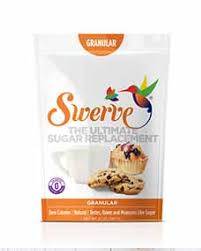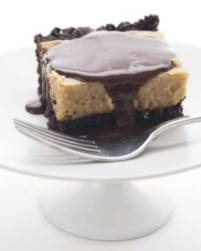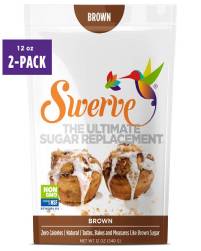Swerve Noncaloric Sweetener With Erythritol Checks All The Boxes
|
Swerve is an erythritol-based sugar substitute that checks all the boxes for anyone seeking a noncaloric sugar substitute. Unlike other sugar alcohols, it causes little or no digestive disruption†. It’s used 1:1 as a replacement for sugar. Unlike other natural non-caloric sweeteners such as monkfruit and stevia, it caramelizes (for cooking) and holds its shape (for baking). What else could one ask for? How about good taste? We’re not partial to the aftertastes in monkfruit and stevia, but erythritol is as natural-tasting—if not more so—than Splenda (which is an artificial sweetener with a flavor we far prefer to monkfruit and stevia—see more below). Plus, Swerve is available in every format one might desire: Head to the Swerve website for recipes, tips, FAQs and to purchase. It’s also available on Amazon at at retailers and other e-tailers. *Non-glycemic means it does not raise blood sugar. †Aspartame (Equal), saccharin (Sweet ‘n Low) and sucralose (Splenda) are considered artificial sweeteners. ‡These include bloating, gas and loose stools. Saccharin (brand name Sweet ‘N Low launched in 1957), the first artificial sweetener, was discovered in 1879 when a chemist at Johns Hopkins, working on coal tar derivatives, inadvertently tasted sweetness on his hand. It is 300 to 500 times sweeter than table sugar by weight. Sucralose (brand name Splenda) was discovered by British researchers in 1976. It is the only non-caloric sweetener made from sugar, but because of the process by which it is made, it is considered an artificial sweetener. It is about 600 times as sweet as sugar. The Splenda brand was launched in the U.S. in 1999. |
|
|
|
Aspartame (brand name Equal), discovered in 1965 is approximately 200 times sweeter than sugar. The brand was launched in the U.S. in 1982. It’s unique among low-calorie sweeteners in that it is completely broken down by the body to its components (amino acids, aspartic acid, phenylalanine and a small amount of ethanol). These components are found in much greater amounts in common foods such as meat, milk, fruits and vegetables, and are used in the body in the same way, whether they come from aspartame or common foods. Acesulfame potassium (called Ace K for short, brand names Sunett and Sweet One) was discovered accidentally in 1967 by a German chemist, it was approved for use in the U.S. in 1988. It is 200 times sweeter than sugar. In 1998, acesulfame K was approved by the FDA for use in beverages (and subsequently for all foods). It is mostly used as a blending sweetener, most prominently paired with aspartame in Coke Zero (Diet Coke uses aspartame only). There are other artificial sweeteners, but these are the most familiar to American consumers. Sugar alcohols were the first-available natural noncaloric sweeteners in Europe and the U.S. Also called polyols, sugar alcohols are organic compounds, derived from the sugars that naturally occur in common foods. The first, sorbitol (derived from potatoes), was discovered by a French chemist in 1872. Subsequent discoveries include erythritol (from corn or wheat), glycerol (from soybean, coconut or palm oils), isomalt (from beets), lactitol (from whey/dairy), maltitol (from corn, tapioca or wheat), mannitol (from sugar), and xylitol (from birchwood), among others. Monkfruit and stevia are also natural noncaloric sweeteners, that have been used for centuries, if not millennia, in Asia and South America, respectively. They were brought to the U.S. over the last 20 years as part of the ongoing search for the ideal noncaloric sweetener for weight management.
|
||



